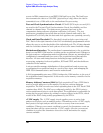
171
Chapter 8: Theory of Operation
Self-Tests Descriptions
configured to take a simple measurement. Test data is then created at the
comparators and an acquisition taken. The resulting data is then downloaded and
compared with known values.
Passing the Clock Path Test implies that all acquisition IC clock lines can be
driven by each acquisition IC and can be received by each acquisition IC in the
module. Consequently each acquisition IC can reliably acquire data in response to
the acquisition clock signal.
Memory Modes Test. The Memory Modes Test verifies the CPU interface can
properly manage the acquisition memory unload in full-channel, half-channel,
count only, and interleaved modes. Test data is written to acquisition memory.
Different unload modes are selected, then the data is read and compared with
known values.
Passing the Memory Modes Test implies that the data can be reliably read from
acquisition memory in full-channel, half-channel, count only, and interleaved
mode. This test along with the Memory Test provides complete testing of
acquisition memory downloading through the 1394 interface.
Calibration Test. The Calibration Test ensures that each acquisition IC in the
module can perform an operational accuracy self-calibration. Various self-
calibration routines are initiated. The results of each self-calibration routine are
then checked to see if the self-calibration was successful or not.
Passing the Calibration Test implies that the module can reliably perform an
operational accuracy self-calibration. Consequently the incoming data path is
optimized to reduce channel-to-channel skew so the acquisition ICs can reliably
capture the incoming data.


















